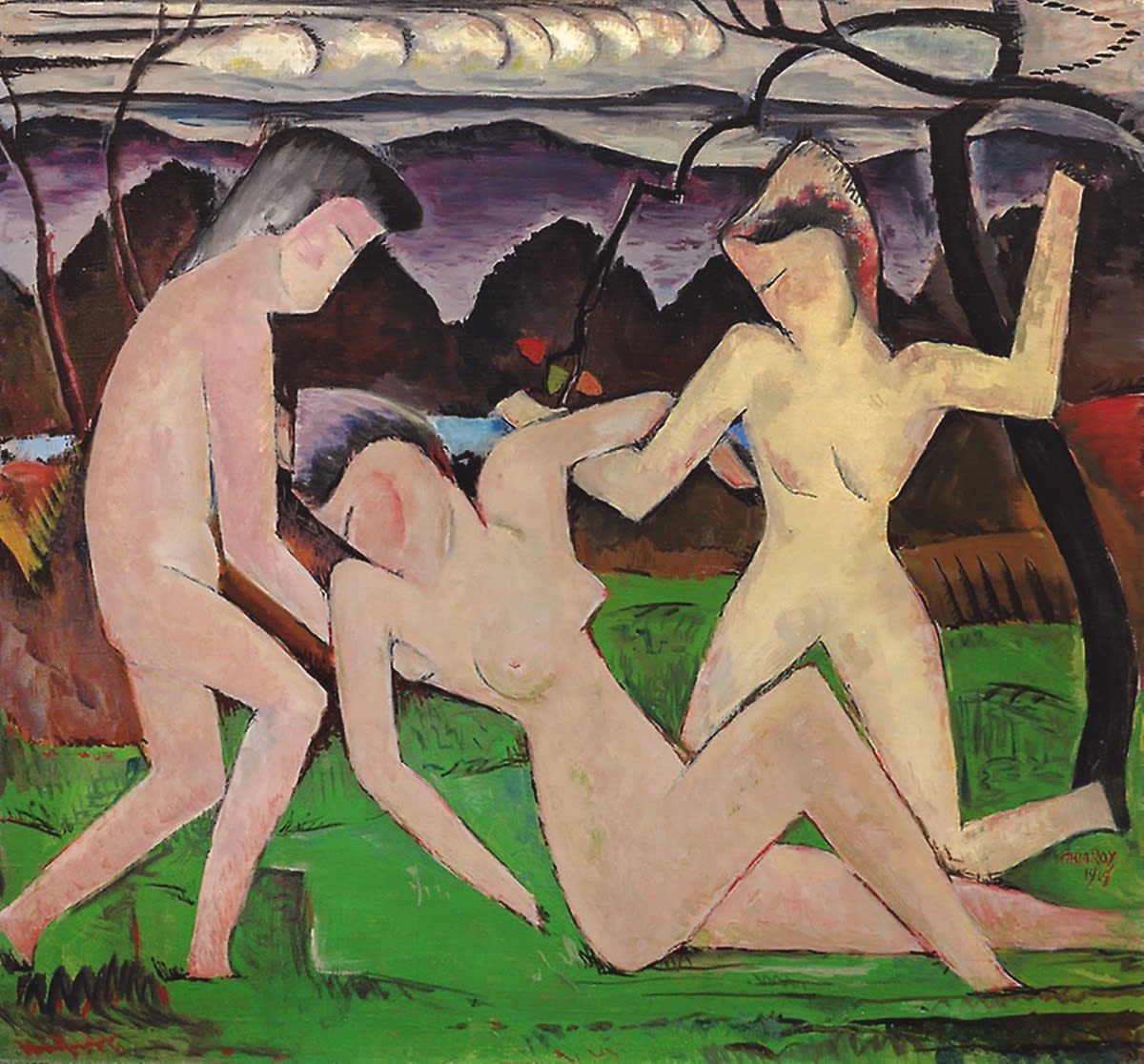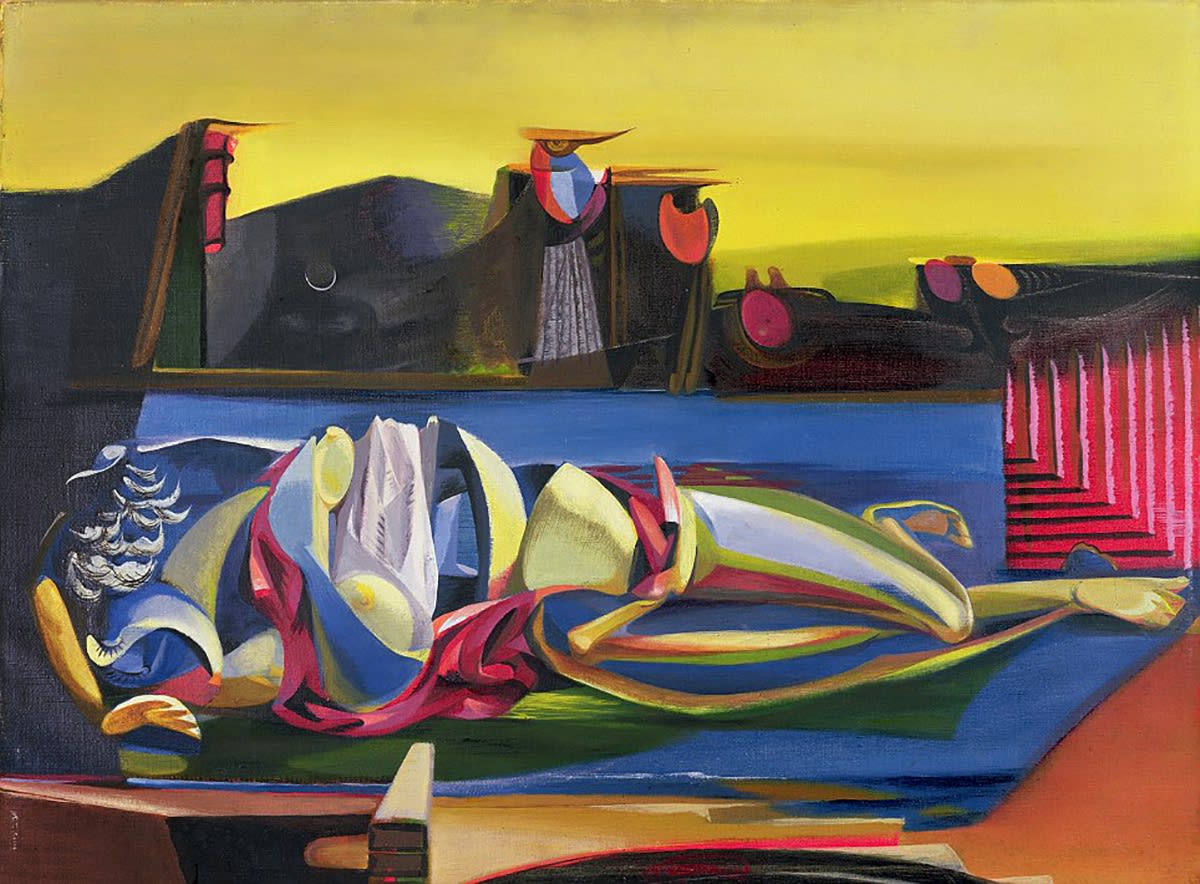F. E. McWilliam
In the middle of the 17th century, the then Lord Holland planted an avenue of mulberry trees at Holland House. His idea was to make his own silk; unfortunately they were the wrong type of mulberry tree for silkworms. A number of these trees survived well into the 20th century, including the two that were in McWilliam's garden, which was just off what is now Holland Park. Sadly on the night of October 15/16 1987, there was the great storm, which devastated much of the woodland of Southern England, and these two were blown down. These lived about 300 years so it was up to Mac to give them a new life; with all the broken branches he made this very exciting series of sculptures, all of which became this show.

Andy Warhol, Colored Campbell's Soup, 1965, silkscreen ink and synthetic polymer paint on canvas 35 5/8 x 24 inches (91 x 61 cm), Berardo Collection
New York May Auctions
In hindsight, the cracks of the coming recession were definitely showing but were masked by the sale at Christie's of Van Gogh's Dr Gachet for $82,500,000, which was a record price at auction and remained so for a long time. To my mind, whatever it fetched would have been a bargain as it's place in Art History can never be questioned, unlike the rather chocolate box Renoir Moulin de la Galette, which was sold by Sotheby's two days later for $78,100,000, which, whatever the price it fetched, would have been too much.
The week before at Sotheby's contemporary sale, I bought two paintings and was so pleased with my purchases that I felt that Sotheby's had almost paid me to attend - how wrong I was and how little did I know what was on the horizon.

Roy Lichtenstein, Oriental Landscape, 1973, oil and magna on canvas, 70 x 42 inches (177.8 x 106.7 cm), Private collection
The first was Warhol's Colored Campbell's Soup, 1965, which had been consigned by a foundation connected to the Des Moines Art Center, who had been given it by Halston, the famous designer and great friend of Andy's. I paid $253,000, presumably, on the reserve with no other bids and a coupleof years later I managed, after much trying, to sell it for $100,000, the buyer trying to make a quick buck put it into a sale at Christies in 1993 where it failed to sell. One is always reading, when is the right time to sell a work of art? the answer is very simple: when you need the money! $100,000 when you need it is much better than $1,000,000 when you don't. The other painting was Lichtenstein's Oriental Landscape, 1973, which was a painting that I had loved ever since I had seen it being painted in Roy's studio. It had been bought by Astrup Fearnley from Beyeler's show in 1973 and he consigned it to Sotheby's where I bought it for $660,000 (I am sure it was on the reserve with no competition). I kept it for about 18 years and lent it to many exhibitions around the world but sadly I had to sell it to a friend in order to pay back a loan to my pension fund.

Man Ray, Departure of Summer, 1914, oil on canvas, 32 1/2 × 35 1/2 inches (82.5 × 90.2 cm), Art Institute of Chicago
Two Old Pals: Man Ray And Roland Penrose
This was another in the series of exhibitions that we did with Timothy Baum and I think that his brilliant catalogue introduction says it all so I am including it now:
Two old pals: in this case creative brethren. One a first generation American (living as much of the time as possible in his beloved Paris, France); the other British (and also a staunch Francophile). Two quite decent fellows. Gentlemen of good demeanour, and high artistic talent; admirers of each other, endowed with the enablement of understanding how to interact.
The two particular experiences they came to share most in common: a pulsating, joyous love of life; the magic of embellishing life that extra little beat by their respective discoveries of, and adherence to, surrealism.
What was surrealism, by the way? A movement of art (and poetry) as life, for one thing; an actual way of living, for another.
And the prerequisites? To truly believe; and love as well.
These men knew the formulae. They came prepared to work and play (alike): good, sharing, able buddies. An entire merry circle there was, in fact. Man Ray and Roland Penrose, assuredly. The wonderful other affinities as Marcel Duchamp, André Breton (growl as he might!), the enchanter Max Ernst, his poet-counterpart Paul Eluard; many others. Quite a wonderful contingent. Gentlemen and ladies. Some famous as Picasso; others so barely known that there is little point in even naming them (all glowing stars, in that especial earthly solar system).
Where did it all begin and end? It didn't, really. There were mousquetaires and Round Tables before, as there will be again, one hopes.
What was so very special was the legitimacy of the friendships that they shared. Good, deep, warm and human ones. Really caring.
History cannot change such bonds. Alliances! Two old pals like this pair: Man Ray, Roland Penrose- helping to bring art back to life, and vice-versa. It is all but a question of spirit actually. Let us twinkle our minds once more, and toast it!
The marvellous thing about this show was that we were able to show what interesting painters they both were - Man was often only thought of as a photographer and Roland as a collector and writer. We sold the Art Institute of Chicago Man's Departure of Summer, 1914, which as far as I know, has been hanging ever since they purchased it and the selection of Roland's work was an eye opener for anybody who didn't know anything of his work.

Roland Penrose, Unsleeping Beauty, 1946, oil on canvas, 23 1/2 x 29 1/2 inches (60 x 75 cm), Sherwin Collection
Claes Oldenburg
In May 1989 Sotheby's sold a group of works from the fabled Karl Stroher Collection, which had been bought en bloc from Leon Kraushar's Estate. Leon Kraushar, who had died in 1967, had been - along with Bob Scull, the Solomons and the Tremaines - one of the main early collectors of Pop Art.
In this sale there were a couple of great works by Claes from the Store Days which I bought. The first was Plate of Meat, 1961 which I sold to Joe Allen and the other was Green Ladies' Shoes, 1962.
I had been told by a friend that S.I. Newhouse was going to buy the shoes come what may. I thought that I would give him a run for his money, only to discover that instead I was bidding against Thomas Ammann who was seated one away from me. In order to avert disaster, I quickly asked him if we could buy the piece together which we did for $462,000. After Thomas's death, I bought out his half share and nearly 18 years later sold it for $1,450,000 to the person who originally thought of buying it from this show. I suppose that the moral of the story is beware of misinformation.

Claes Oldenberg, Green Ladies' Shoes, 1962, muslin soaked in plaster over wire frame, painted with enamel, 11 3/4 x 16 x 16 3/4 inches (30 x 40.5 x 42.5 cms), Private Collection

